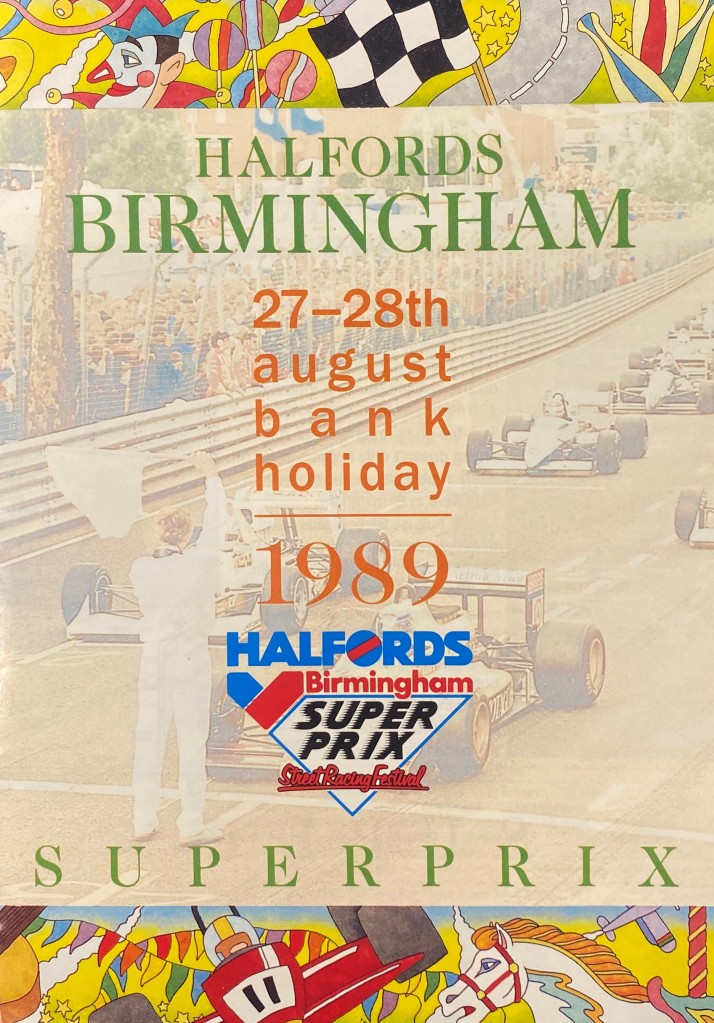Birmingham has an illustrious history of motor racing; for those of us old enough to remember, think back to when Nigel Mansell won the Formula One World Championship in 1992, and who can forget the impassioned commentary of Hall Green alumni Murray Walker? I think Nigel spent his formative years in Hall Green, a veritable hotbed of activity in the world of motor sport.
The Background
Some might suggest it was then only a matter of time before Birmingham staged its own competitive motor race, the Birmingham Super Prix, and that’s what happened first in August 1986. The inaugural race was the culmination of years of setbacks and successes to make the event a reality. In the ‘Chequered History of the Birmingham Super Prix’ by Brian Pearce and Maureen Alcott (which I have used as the main source of my research), Martin Hone and Peter Barwell are credited with being the driving force behind the original idea for a Birmingham motor race. Talks had been taking place since the 1970s to get the event up and running. Birmingham didn’t have access to a Grand Prix circuit such as Silverstone so where would the event be held? Suggestions of a road race similar to the one run along the streets of Monaco were mooted. After subsequent rounds of talks, the Super Prix became part of the International Formula 3000 championship, also known as Formula 2 which is where future stars of the Formula 1 circuit tested their pedal power. British Formula 1 drivers such as Martin Blundell and 1996 world champion, Damon Hill participated. Several winners of the race such as Jean Alessi went on to steer careers as Formula 1 drivers.
The Race Circuit
The circuit was 2.47 miles long. The start and finish line was outside Monaco House on Bristol Street, an area of the city associated with vehicle propulsion, be it of the horse drawn variety represented by the name of that part of the city centre, Horsefair, or the motor generated variety via Bristol Street Motors and Monaco House which was opened in the 1970s. After the revving of engines on the start line, cars turned left into Belgrave Middleway and motored up to the island at the Pershore Road junction and then powered on to the island at Haden’s Circus, also known as Halford’s Corner. Turning at the island, the cars came back down Belgrave Middleway and then turned on to Sherlock Street, then Pershore Street and then on to Bromsgrove Street and finally on to Bristol Street to start all over again. All of this was in the opposite direction to the usual flow of traffic. Please see my very basic pen drawing of the circuit below:
The Race
Pierluigi Martini was on pole position for the first Birmingham Super Prix race on 25 August 1986. The good old British weather played its part with torrential rain delaying the start as water got into the electrics of the starting equipment. The rain persisted and on lap 24 a decision was made to end the race after two cars collided blocking the race course.

The Super Prix then continued for a further four years. Here’s a list of the winners:
- 1986 – Luis Sala
- 1987 – Stefano Modena
- 1988 – Roberto Moreno
- 1989 – Jean Alessi
- 1990 – Eric van de Poele
The lap record for the Super Prix was 1 min, 22.91 seconds with a speed of 107.24 mph set by Roberto Moreno in 1987. Along Belgrave Middleway, speeds of up to 170 mph were recorded.
Birmingham Super Prix, August 1989. Photograph by Birmingham City Council Development Department Photographic Section [Ref. No. WK/B11/7733]
The End
An Act of Parliament had been passed in 1985 allowing the Birmingham Super Prix to take place and it received cross party support from Birmingham MPs. Political voices in support of the race pointed to crowd numbers for the event which exceeded 80,000 spectators. The race was also considered a good advertisement for the city, but opposing voices raised issues with the cost and just how many business opportunities it brought to Birmingham. In 1990, it was disclosed that the five races lost a total of two million pounds. A decision was then made to privatise the event, offering the franchise to a suitable bidder. Several interested parties entered the frame but eventually a backer was not found. Birmingham City Council’s second Bill seeking authorisation to proceed with a privately financed operation was stalled in Parliament. There hasn’t been a Birmingham Super Prix since 1990.
Reading List
If you are interested in exploring the Birmingham Super Prix further, here is a list of materials held in Archives & Collections:
- Birmingham Super Prix, Birmingham City Council (No.2) Bill (LF 25.7)
- Birmingham Super Prix Official Souvenir Programmes – 1986, 1987, 1990 (LF 25.7)
- Birmingham Super Prix newscuttings – 1987, February 1990 – April 1993. (LF 25.7)
- Birmingham Super Prix, Box of miscellaneous documents, plans and brochures, 1980s. (LF 25.7)
- The Chequered History of the Birmingham Super Prix by Brian Pearce and Maureen Alcott, 1993 (LF 25.7)
Paul Taylor, Archives & Collections Coordinator




Reblogged this on Andrew James.